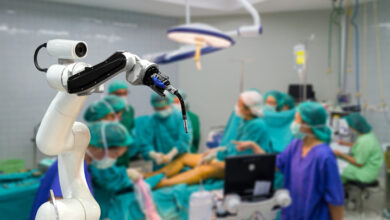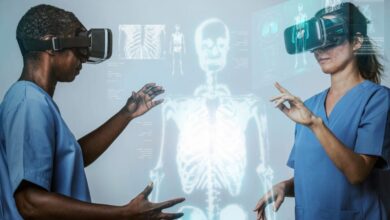Wearables And The Future Of Preventive Health

Wearables and the Future of Preventive Health sets the stage for an exploration into how technology is revolutionizing our approach to health management. With the rapid evolution of wearable devices, individuals now have the capability to monitor their health statistics in real-time, ultimately leading to better health outcomes and a proactive stance against potential diseases. From fitness trackers to advanced medical wearables, these devices are not just trends but pivotal tools in enhancing preventive health measures.
As we dive deeper into the realm of wearables, we will discuss various types of devices, their functionality, and the crucial role they play in continuous health monitoring. This narrative will also touch upon privacy concerns surrounding health data collection and the future advancements poised to transform the healthcare landscape.
Introduction to Wearables in Healthcare
Wearables in healthcare have emerged as a game-changing technology, transforming the way individuals monitor and manage their health. These devices, which can be worn on the body, collect real-time data on various health metrics and provide valuable insights that empower users to take charge of their well-being. From fitness trackers to smartwatches, wearables play a crucial role in preventive health by facilitating early detection and continuous monitoring of health conditions.
The evolution of wearable technology has significantly impacted health management over recent years. Initially designed for fitness enthusiasts, wearables have evolved to incorporate advanced sensors and connectivity features that enable medical-grade monitoring. This shift has facilitated a broader application of wearables in clinical settings, aiding in the management of chronic diseases, patient engagement, and overall health awareness. Moreover, the integration of artificial intelligence and data analytics further enhances the capabilities of these devices, allowing for personalized health recommendations and interventions.
Popular Wearable Devices in the Market
The current market is flooded with a variety of wearable devices, each offering unique functionalities that cater to different health needs. These devices enhance user engagement in health management and provide a wealth of data that can contribute to a comprehensive understanding of personal health.
– Fitness Trackers: Devices like Fitbit or Garmin provide features such as step counting, heart rate monitoring, and sleep tracking. They are particularly popular among individuals looking to maintain an active lifestyle.
– Smartwatches: Examples include the Apple Watch and Samsung Galaxy Watch, which not only track fitness metrics but also provide notifications, apps, and ECG functions, enabling users to monitor their health on the go.
– Continuous Glucose Monitors (CGMs): Devices such as the Dexcom G6 facilitate real-time glucose monitoring for individuals with diabetes, allowing for timely adjustments in insulin and diet.
– Wearable ECG Monitors: Products like the AliveCor KardiaMobile allow users to take electrocardiograms (ECGs) at home, helping to detect arrhythmias and other heart conditions early on.
The diversity of these devices illustrates the growing intersection of technology and health, showcasing how wearables can enhance preventive health measures and facilitate a healthier lifestyle.
Types of Wearable Devices
Wearable devices have rapidly evolved into essential tools for managing health and wellness. With a wide range of functionalities and design, these devices now cater to diverse needs, from fitness enthusiasts to individuals requiring medical monitoring. Understanding the different types of wearable devices and their specific functions is crucial for selecting the right one for health management.
The primary categories of wearable devices include fitness trackers, smartwatches, and medical wearables. Each type serves distinct purposes and offers varying functionalities, tailored to different user needs. Fitness trackers emphasize activity monitoring and health metrics, smartwatches combine fitness capabilities with smartphone functionalities, while medical wearables focus on health monitoring for chronic conditions and critical health metrics.
Categories of Wearable Devices and Their Functions
The following Artikels the key categories of wearable devices and their specific functions, highlighting the unique features that distinguish them from one another.
| Device Type | Key Functions | Examples |
|---|---|---|
| Fitness Trackers |
| Fitbit Charge 5, Garmin Vivosmart 4 |
| Smartwatches |
| Apple Watch Series 8, Samsung Galaxy Watch 5 |
| Medical Wearables |
| Dexcom G6, AliveCor KardiaMobile |
“Wearable devices provide personalized health insights, empowering individuals to take proactive steps towards their wellbeing.”
This table demonstrates the diverse functionalities of each type of wearable device, making it easier for users to identify which device best suits their lifestyle and health needs. By understanding these differences, consumers can make informed choices that enhance their health management strategies.
Preventive Health and Wearables
Wearable technology has emerged as a pivotal player in the healthcare landscape, especially in the realm of preventive health. These devices offer individuals unprecedented access to their health data, empowering them to take proactive steps towards wellness. By incorporating wearables into daily routines, users can not only monitor their health metrics but also make informed decisions that can avert potential health issues.
The integration of wearables into preventive health measures is primarily rooted in their ability to facilitate continuous health monitoring. This ongoing observation allows for the early detection of abnormalities and encourages timely interventions. As a result, individuals are more likely to engage in healthier behaviors and manage chronic conditions effectively.
Continuous Health Monitoring and Disease Prevention
The significance of continuous health monitoring cannot be overstated, as it plays a crucial role in identifying risks before they escalate into serious health problems. With wearables equipped with sensors that track vital signs and physical activity, users can receive real-time feedback on their health status. This constant stream of data can lead to lifestyle adjustments that reduce the likelihood of developing chronic diseases.
Key benefits of continuous health monitoring through wearables include:
- Real-time data tracking: Wearables provide users with immediate insights on metrics such as heart rate, blood pressure, and sleep patterns, enabling them to make timely health decisions.
- Early detection of health issues: Abnormal readings can alert users to potential health risks, prompting them to seek medical advice before conditions worsen.
- Personalized health recommendations: Many wearables offer tailored suggestions based on individual health data, guiding users towards healthier lifestyle choices.
Case Studies in Wearables and Preventive Health
Numerous case studies demonstrate the successful application of wearables in enhancing preventive health outcomes. One notable example involves a randomized control trial that assessed the impact of wearable fitness trackers on participants with prediabetes. The study revealed that those utilizing the devices showed significant improvements in physical activity levels and weight loss compared to those without wearables. Participants engaged more actively in their health management, ultimately leading to a reduction in their risk of progressing to type 2 diabetes.
Another compelling case is the use of smartwatches in monitoring heart health. In a study published in the Journal of Medical Internet Research, researchers found that individuals using smartwatches capable of detecting irregular heart rhythms experienced a higher rate of diagnosis for atrial fibrillation. This early detection allowed for timely interventions, significantly reducing the risk of stroke in at-risk populations.
These case studies highlight the potential of wearables not just as fitness tools, but as integral components of preventive health strategies that can help individuals maintain their health and wellbeing.
Data Collection and Privacy Concerns
Wearable devices have revolutionized health tracking by allowing users to collect a wide range of health data. These devices, such as smartwatches and fitness trackers, gather information about users’ physical activities, heart rates, sleep patterns, and more. However, while the benefits of monitoring health through wearables are significant, they also raise pressing concerns regarding data privacy and security.
The types of health data collected by wearables include biometric data, activity levels, and physiological measurements. Biometric data can range from heart rate and blood pressure to oxygen saturation levels. Activity data typically tracks steps taken, calories burned, and exercise duration. Sleep data provides insights into sleep duration and quality, which can be crucial for identifying potential health issues. This information is significant as it allows individuals to gain insights into their health and make informed decisions about their lifestyles. However, the extensive nature of the data collected poses significant privacy concerns.
Privacy Issues Related to Health Data Sharing
The sharing of health data collected by wearable devices raises important privacy issues. Users may unknowingly expose sensitive information to third parties, including manufacturers, app developers, and even insurers. The risks include potential data breaches, misuse of personal health information, and unauthorized access. Wearable manufacturers often collect data to improve their services and provide personalized experiences, but users may not be fully aware of how their data is used, stored, or shared.
To address these privacy concerns, users should take proactive steps to protect their data while using wearables. Here are some recommendations:
- Read Privacy Policies: Users must review the privacy policies of wearable devices and applications to understand how their data is handled.
- Limit Data Sharing: Only share information that is necessary and avoid granting excessive permissions to applications.
- Use Strong Passwords: Implement strong, unique passwords for accounts linked to wearables to protect against unauthorized access.
- Enable Two-Factor Authentication: Whenever possible, enable two-factor authentication for added security on accounts associated with wearable devices.
- Update Regularly: Keep the wearable device software updated to benefit from the latest security patches and improvements.
- Monitor Data Access: Regularly review which applications and services have access to health data and revoke permissions as necessary.
By following these recommendations, users can significantly enhance their data privacy and ensure that their health information remains secure while enjoying the benefits of wearable technology.
Future Trends in Wearable Technology
The landscape of wearable technology is evolving rapidly, with new trends emerging that promise to reshape the future of healthcare. As consumers become increasingly health-conscious and technology advances, wearables are poised to play a pivotal role in preventive health management and personalized medical care. This section explores the anticipated trends that will influence the integration of wearables in the healthcare ecosystem.
Advancements in sensor technology are at the forefront of these developments, paving the way for more precise health tracking and monitoring. These innovations are not only enhancing the functionality of existing devices but also opening up new avenues for health data collection and analysis. As sensors become smaller, more accurate, and capable of measuring a wider range of health metrics, the potential applications in healthcare become more extensive.
Emerging Trends in Wearable Technology
A variety of trends are emerging in wearable technology that have the potential to significantly impact healthcare delivery and patient outcomes. These shifts are driven by consumer demands for greater health insights and the capabilities of advancing technology.
- Integration with Artificial Intelligence (AI): Wearables are increasingly incorporating AI to analyze health data in real-time, offering users personalized insights and recommendations based on their unique health profiles.
- Augmented Reality (AR) Wearables: These devices are being developed to provide immersive experiences that enhance patient education and training, allowing for better understanding and adherence to health protocols.
- Telehealth Integration: The rise of telehealth services is leading to wearables that seamlessly connect patients with healthcare providers, facilitating remote monitoring and consultations.
- Advanced Biometrics: New sensors are being developed to track complex biometrics such as hydration levels, blood glucose fluctuations, and even emotional states, providing a more comprehensive view of health.
- Smart Clothing: Wearable technology is moving beyond traditional wrist devices to include smart fabrics that monitor health metrics through clothing, offering continuous data collection without user intervention.
“By 2025, it’s predicted that the integration of AI in wearables will allow for proactive health management, instead of reactive treatment, paving the way for a new era in healthcare.” – TechHealth Analyst
These trends highlight the increasing complexity and capability of wearable devices, making them an essential component of future healthcare strategies. With these advancements, wearables will not only enhance individual health tracking but also streamline healthcare operations, improving overall patient care and outcomes.
Integration with Healthcare Systems: Wearables And The Future Of Preventive Health
The integration of wearable technology into existing healthcare systems offers a transformative opportunity for enhancing patient care and outcomes. By seamlessly connecting these devices to healthcare infrastructures, providers can access real-time data that aids in the monitoring and management of patient health. This integration not only streamlines the workflow for healthcare professionals but also empowers patients by providing them with actionable insights into their health.
Collaboration between technology companies and healthcare providers is crucial in enhancing the functionalities of wearable devices. As tech firms innovate new wearable technologies, they work closely with healthcare experts to ensure that these devices meet clinical standards and address real-world health challenges. This partnership facilitates the development of wearables that are not just sophisticated gadgets but essential tools for preventive health and chronic disease management.
Seamless Integration Framework, Wearables and the Future of Preventive Health
Creating a framework for the seamless integration of wearables in clinical settings is essential for maximizing their potential. Such a framework involves several key components:
1. Interoperability Standards: Establishing common protocols ensures that data from various wearable devices can be easily shared and understood across different healthcare systems. This promotes a unified approach to patient data management.
2. Data Security Measures: Given the sensitive nature of health information, implementing robust security protocols is crucial. This includes encryption of data both in transit and at rest, as well as strict access controls to protect patient information.
3. User-Friendly Interfaces: Designing intuitive interfaces for healthcare providers and patients enables easier navigation and interaction with wearables. This encourages higher adoption rates among both healthcare professionals and patients.
4. Real-Time Data Analytics: Incorporating advanced analytics capabilities allows healthcare providers to process and interpret data collected from wearables in real-time. This supports proactive decision-making and timely interventions.
5. Patient Engagement Tools: Providing tools that encourage patients to engage with their health data fosters a sense of ownership over their own health outcomes. This can include mobile applications that allow patients to view their metrics and receive personalized feedback.
6. Clinical Training Programs: Educating healthcare professionals on how to effectively use and interpret data from wearables is vital. This ensures that clinicians can leverage these devices to enhance patient care.
7. Feedback Loops: Establishing mechanisms for continuous feedback from both patients and healthcare providers allows for ongoing improvement of wearable technologies and their integration into clinical practices.
The successful integration of wearable devices into healthcare systems promises to revolutionize the way patient health is monitored and managed, leading to improved outcomes and enhanced quality of care.
Challenges and Limitations
The integration of wearable technology in healthcare is not without its hurdles. While these devices promise enhanced preventive health measures, their widespread adoption faces several challenges that can hinder their effectiveness. Understanding these challenges is essential for stakeholders aiming to leverage wearables for health improvements.
One significant challenge is the disparity in user adoption rates across different demographics. Many individuals, particularly older adults, may be resistant to using new technology due to lack of familiarity or perceived complexity. Additionally, the cost of advanced wearable devices can be prohibitive for some consumers, limiting access to those who could benefit the most. Furthermore, there are technical limitations such as battery life, device accuracy, and the need for constant connectivity, which can impact usability and reliability.
Data Accuracy and Reliability
The accuracy of data collected by wearable devices is crucial for effective health monitoring and preventive measures. Current wearables often struggle with precision, leading to potential misinterpretations of health data.
Factors affecting data accuracy include:
- Environmental Conditions: Poor sensors can yield inaccurate readings if the device is not designed to function under specific environmental factors like humidity or temperature.
- User Variability: Differences in how users wear devices or interact with them can lead to inconsistent data capture. For example, a heart rate monitor may provide different readings depending on how tightly it is strapped to the wrist.
- Calibration Issues: Many wearables require regular calibration for optimal functioning, and failure to do so can result in erroneous data.
The implications of inexact data can be severe, from missed health alerts to unnecessary anxiety over false positives. To enhance reliability, manufacturers should prioritize rigorous testing and invest in improving sensor technology.
Privacy and Security Concerns
With the rise of wearables comes the critical issue of data privacy and security. Sensitive health data is often transmitted and stored in cloud services, raising risks associated with data breaches.
Key considerations include:
- Data Encryption: Wearable devices must implement robust encryption protocols to protect user data during transmission and storage, preventing unauthorized access.
- User Consent: Clear policies on data usage and sharing should be established to ensure users are fully informed about how their data is handled.
- Regulatory Compliance: Compliance with regulations such as HIPAA is essential to safeguard patient information and build trust among users.
Addressing these concerns through transparent practices and advanced security measures can significantly enhance user confidence in wearable technology.
Integration with Existing Healthcare Systems
The seamless integration of wearable technology into existing healthcare systems is a major challenge that needs to be addressed for widespread adoption.
Important factors include:
- Interoperability: Wearables must be able to communicate effectively with various healthcare software systems to share data without friction.
- Standardization: Establishing common standards for data formats and protocols can facilitate smoother integration and better data exchange.
- Healthcare Provider Training: Adequate training for healthcare professionals is crucial to ensure they can effectively interpret and utilize data from wearables.
Enhancing collaboration between tech developers and healthcare providers can lead to more effective solutions that fully leverage the potential of wearable technology.
Conclusive Thoughts
In conclusion, the journey of wearables and their impact on preventive health is just beginning. As technology continues to advance, the integration of these devices into healthcare systems promises to enhance patient outcomes and facilitate better disease prevention strategies. By addressing existing challenges and privacy concerns, the future holds the potential for a healthier society empowered by innovation, making wearables an indispensable companion in our healthcare journey.
Popular Questions
What are wearable devices?
Wearable devices are technology items that can be worn on the body, such as smartwatches, fitness trackers, and health monitors, designed to collect health-related data.
How do wearables help in preventive health?
Wearables assist in preventive health by enabling continuous monitoring of vital signs, tracking physical activity, and providing users with insights that encourage healthier lifestyle choices.
Are there any privacy concerns with wearables?
Yes, privacy concerns exist regarding the collection and sharing of personal health data, which can be vulnerable to hacking and unauthorized access.
Can wearables predict health issues?
While wearables can offer insights into health trends and alert users to irregularities, they do not predict health issues with certainty but can aid in early detection.
What is the future of wearables in healthcare?
The future of wearables in healthcare looks promising, with advancements in technology expected to enhance their accuracy and integration into clinical settings, improving patient outcomes.







